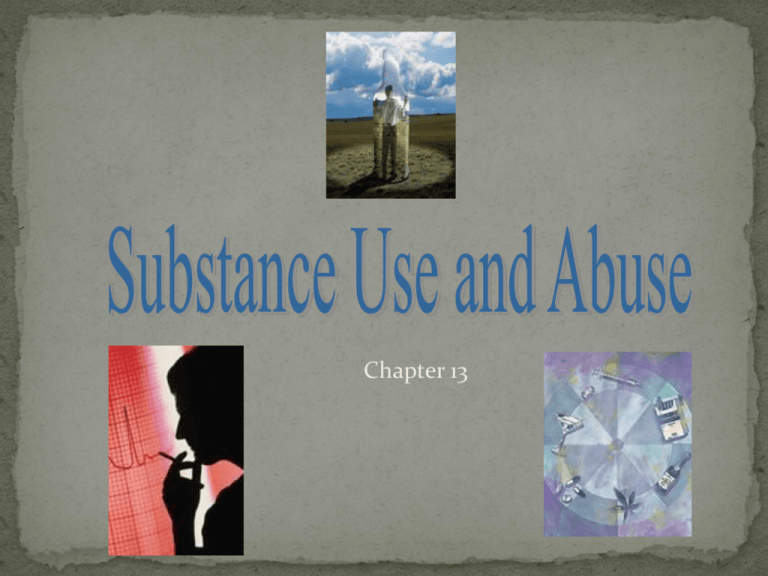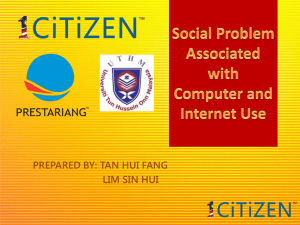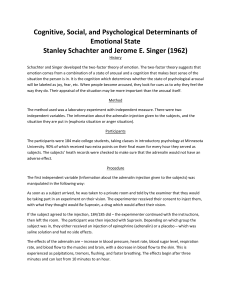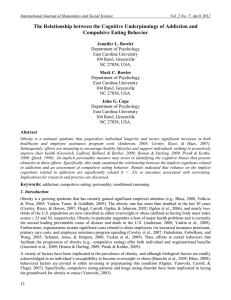
Chapter 13
Habits that have gotten out of control, with a
resulting negative effect on a person’s health.
Addiction is the habitual use of a drug produced
chemical changes in the user’s body.
Drug Addiction (four important characteristics)
Compulsive desire
2. Need to increase the dosage
3. Harmful effects to the individual
4. Harm to society
1.
2
Often starts to bring pleasure or to avoid pain.
Harmless or even beneficial if done in moderation
Examples of addictive behaviors:
Gambling
Compulsive Exercising
Work Addiction
Sex and love addiction
Compulsive buying or shopping
Internet addiction
Characteristics of people with addition (e.g., risk takers or
genetic disposition)
3
Drugs are chemicals other than food that are intended
to affect the structure or function of the body
Prescription medicines
Over-the-counter substances
Caffeine
Tobacco
Alcohol
Illegal substances
4
The APA’s Diagnostics and Statistical Manual of
Mental Disorders – authoritative reference
Abuse
APA definition
Failure to fulfill major responsibilities
Drug use in situations that are hazardous
Drug related legal problems
Drug use despite persistent social or interpersonal problems
Physically dependent may or may not present
5
Substance dependence
1. Developing tolerance to the substance
2. Experiencing withdrawal
3. Taking in larger amounts
4. Expressing a persistent desire to cut down
5. Spending great deal of time obtaining
6. Giving up or reducing important activities
7. Continual usage even with recognition of a
problem
Diagnosed with at least 3 or more symptoms
during a 12-month period
6
All income and education levels
All ethnic groups
All ages
Young people are at a higher risk
Males (Twice as likely)
Troubled adolescent
Thrill-seeker
Dysfunctional families
Peer group or family that accepts
Low Socio-economical status
Dating young
7
Experiment
Escape
Reliance
Magnification of residence (i.e. the need for escape
from poverty becomes more compelling)
8
Psychological risks
Difficulty in controlling impulses
Strong need for excitement
Feelings of rejection
Hostility
Aggression
Anxiety
Mental illness
Dual (co-occurring disorders)
9
Social Factors
Growing up in a family with drug abuse
Peer group
Poverty
10
Intoxication
Side effects
Unknown drug constituents
Risks associated with injection drug use
Legal consequences
11
Changes in Brain chemistry
Drug factors:
Pharmacological properties
Dose-Response function
Time-action function
Drug use history
Method of use (e.g., inhalation,
injection, ingest)
12
Opioids (narcotics)
Natural or synthetic (laboratory-made)
Opium, morphine, heroin, methadone, codeine,
hydrocodone, oxycodone, meperidine, and fentanly
Effects on the body: induced euphoria
Methods of administration
Injection, snorting, sniffing or smoking
Symptoms of overdose: respiratory depression, coma,
constriction of the pupils, or death.
13
Slow down the overall activity of the CNS
Sedative-hypnotics
Types: barbiturates, valium, methaqualone, GHB
Effects on the body: reduce anxiety, impair muscle
coordination, induce drowsiness
Medical uses: Treat insomnia and anxiety disorders;
control seizures
From use to abuse (“Club Drugs”)
Overdosing may result in respiratory
complications
15
Speed up the activity of the nervous or muscular
system
Cocaine
Methods of use (snort or injection)
Effects (euphoria sensation for ~5 to 20 minutes)
Use during pregnancy (consequences include:
miscarriage, premature labor, stillbirth, and low-birth-weight
baby)
16
Amphetamines
Effects (increase in alertness)
Dependence (may lead to the development of a temporary
state of paranoid psychosis or delusion)
Ritalin (used to treat attention-deficit/hyperactivity
disorder, ADHD)
Ephedrine (a less potent form of amphetamines)
Caffeine
18
19
Cannabis Sativa
THC (tetrahydrocannabinol)
Short term effects and uses: euphoria, increases in
sensation, relaxed attitude
Long-term effects and uses: respiratory damage such
as impaired lung function and chronic bronchial
irritation
21
Altered state of consciousness, perceptions, feelings and
thoughts
LSD, Mascaline, DMT, MDMA, Ketamine, PCP (angel
dust), and certain mushrooms
Altered states of consciousness
Flashbacks are perceptual distortions and bizarre
thoughts that occur after the drug has been entirely
eliminated from the body.
23
Nearly all inhalants produce effects similar to those of
anesthetics, slow down the bodies functions
Volatile solvents
Nitrates
Anesthetics
Methods of use
Sniffing
Snorting
“Bagging”
“Huffing”
24
Medication-assisted treatment
Drug substitution
Treatment centers
Self-help groups and peer counseling
Harm reduction strategies
Codependency
http://www.youtube.com/watch?v=J46pvxFWNTY
25
26
© 2010 McGraw-Hill Higher Education. All rights reserved.











